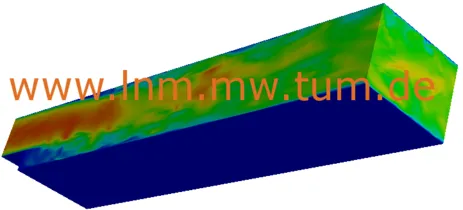Variable-Density Flow
Volker Gravemeier
This method is particularly supported by the Emmy Noether Research Group.
Variable-density flow at low Mach number, also often referred to as thermally-coupled flow, is often encountered in engineering and nature. Problems of combustion in the form of deflagrations, that is, flames at low speed, are usually mathematically described by a variable-density formulation of the Navier–Stokes equations for low-speed flows. Such a formulation poses additional challenges in comparison with, on the one hand, an incompressible formulation of the Navier–Stokes equations, since it has to be accounted for the temperature distribution and potentially large density variations in the flow domain due to substantial temperature differences. On the other hand, in comparison with a compressible formulation, the acoustic modes are filtered out of the formulation.
We recently developed a comprehensive computational method based on multiscale and stabilized methods which is capable of simulating all regimes of variable-density flow at low Mach number, from laminar via transitional to the particularly challenging turbulent flow regime. Both a partitioned and a monolithic solution approach are available. These computational methods are used for our research projects on combustion, for example. Currently, they are further extended towards thermo-fluid-structure interaction (TFSI).


Publications
Please find publications on this topic here.